Mark Sisson's Blog, page 124
November 10, 2018
Keto Turkey Gravy
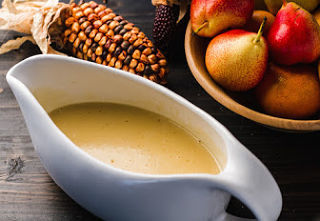 Among the best parts of slow roasting meat are the delicious drippings. Rich, savory and flavorful liquid gold… To discard it, we’d suggest, borders on criminal.
Among the best parts of slow roasting meat are the delicious drippings. Rich, savory and flavorful liquid gold… To discard it, we’d suggest, borders on criminal.
While there’s nothing wrong with enjoying drippings on their own, most of us grew up enjoying the creamy texture of gravy on meats and vegetables. For some, it’s an indispensable element in a real holiday meal. And there’s no reason to deprive yourself if gravy is your thing. Even if you’re living keto, this recipe keeps your commitment. Most of all, it feels and tastes like indulgence itself.
Serving: 4
Time: 10 minutes
Ingredients:
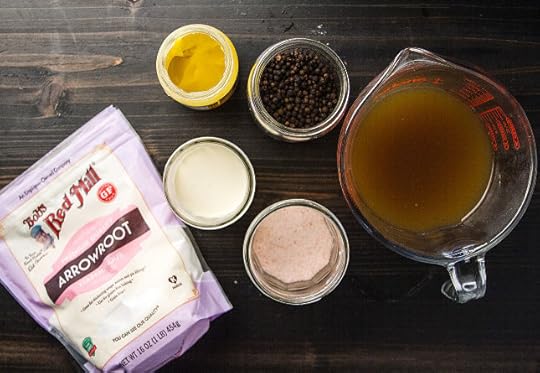
2 cups turkey drippings, bone broth, or stock
½ cup heavy whipping cream
4 tablespoons butter or ghee
½ teaspoon salt
¼ teaspoon black pepper
1 1/2 teaspoon arrowroot powder
Instructions:
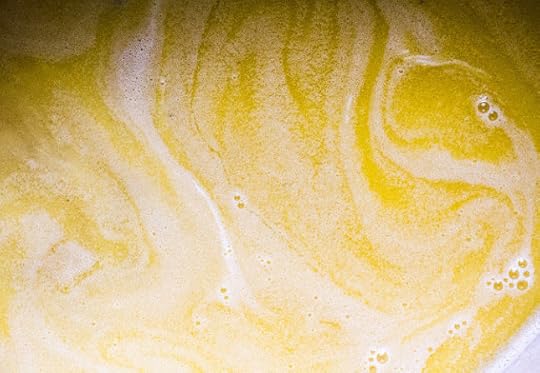
Combine cream, butter, broth/drippings in a saucepan over medium-high heat. Bring to a boil and then reduce to simmer for 10–15 minutes. Add arrowroot powder, salt, and pepper. Stir until gravy thickens and reduces down to consistency of your liking.
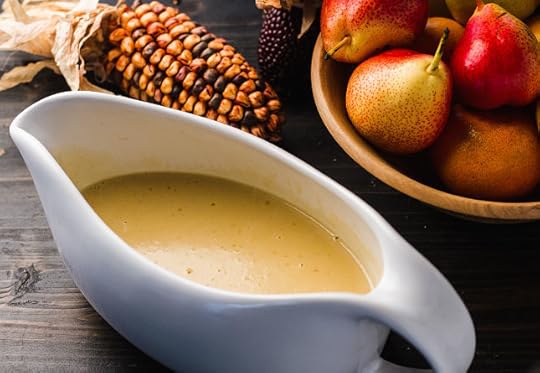
Nutritional Info (per serving):
Calories: 693
Carbs: .8 grams
Fat: 75 grams
Protein: 0 grams

The post Keto Turkey Gravy appeared first on Mark's Daily Apple.



Scalloped Potatoes
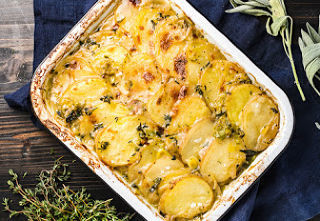 For many people, potatoes are synonymous with Thanksgiving dinner. And while the carb count of potatoes suggests moderation is best, at the holidays many Primal types choose to fit tradition into their eating plan.
For many people, potatoes are synonymous with Thanksgiving dinner. And while the carb count of potatoes suggests moderation is best, at the holidays many Primal types choose to fit tradition into their eating plan.
Mashed potatoes might be the go-to, but another flavorful option is scalloped potatoes. It’s the perfect complement for beef and ham, of course, but with the taste of traditional herbs like sage and thyme, you might have a new favorite dish for your holiday turkey meals as well.
This recipe uses coconut cream and ghee, but you can substitute regular whipping cream and butter if you tolerate dairy.
Serving: 8
Time: 80 minutes
Ingredients:
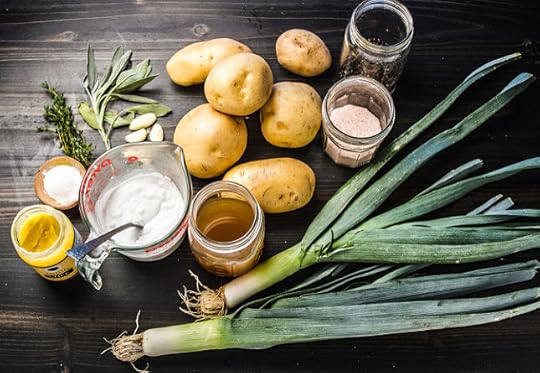
3 pounds large yellow potatoes
2 leeks, white and light green parts, cleaned of all sand and sliced thinly
4 cloves garlic, minced
1 tablespoon Primal Kitchen Avocado Oil
3 tablespoons butter or ghee, plus more for greasing casserole dish
1/2 cup full-fat canned unsweetened coconut cream
1 cup chicken bone broth
1 tablespoon arrowroot powder
Salt and pepper
4 sprigs fresh thyme, leaves removed
4 leaves fresh sage, stems removed and chopped finely
Instructions:
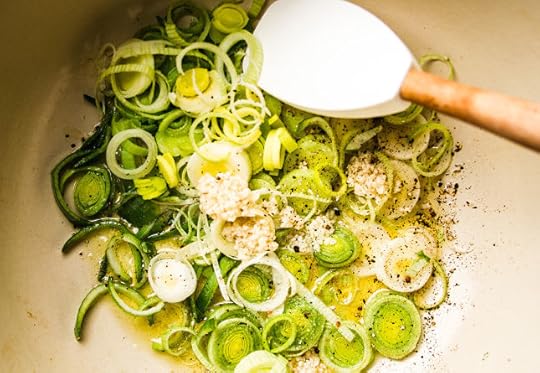
Preheat oven to 350ºF.
Peel the potatoes then, using a mandolin or a knife, slice the potatoes 1/4-inch thin. Set aside.
Heat 1 tablespoon avocado oil and 1 tablespoon butter or ghee in a skillet over medium-high heat. Add the sliced leeks, 2 cloves minced garlic, and season with salt and pepper. Saute until leeks are very tender, about 5–7 minutes.
Combine the leek saute and the sliced potatoes in a large bowl and toss to coat evenly. Season generously with salt and pepper.
Butter a casserole dish lightly, then spread the potato and leek mixture across the dish evenly.
In the same skillet you used before, heat 2 tablespoons butter or ghee over medium heat. Add garlic and gently fry for about 30 seconds to 1 minute, being careful not to burn. In a small bowl, combine the chicken bone broth with 1 tablespoon arrowroot starch, and whisk until arrowroot is dissolved. Pour the chicken broth mixture into the skillet along with 1 cup of coconut milk. Whisk to combine. Add the fresh thyme and sage leaves and some salt and pepper, to taste, and let simmer for about 5 minutes, stirring often, until the sauce thickens up a bit.
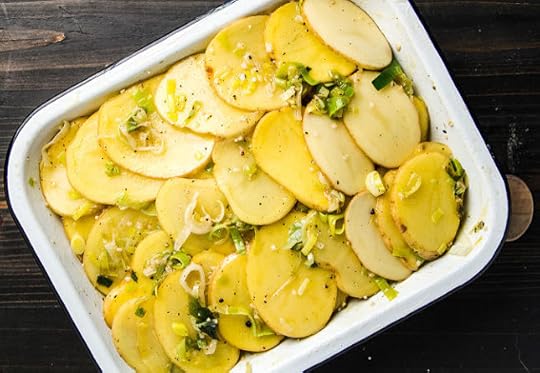
Pour the sauce over the potatoes in the casserole dish. Seal tightly with foil and bake for 40 minutes. Uncover and continue to bake for 15 more minutes. When cooking time is complete, if your potatoes are not golden brown on top, turn your oven on ‘broil’ and broil for 3–5 minutes, watching carefully so the top gets golden brown but doesn’t burn.
Remove from oven and let cool for 10–15 minutes for the sauce to thicken before serving.

Nutritional Info (per serving):
Calories: 282
Carbs:42 grams
Fat: 11 grams
Protein: 5 grams

The post Scalloped Potatoes appeared first on Mark's Daily Apple.



November 9, 2018
I Was Blown Away That I Could Lose Weight Without Running!
It’s Friday, everyone! And that means another Primal Blueprint Real Life Story from a Mark’s Daily Apple reader. If you have your own success story and would like to share it with me and the Mark’s Daily Apple community please contact me here. I’ll continue to publish these each Friday as long as they keep coming in. Thank you for reading!

This may not look like your typical success story, but it’s still a primal success nonetheless! I have been blessed in that I’ve never had any illnesses or struggles with health. I’ve always been super active and that had helped me maintain a healthy weight, even throughout three pregnancies. My passion for running has always been deep and I completed my first marathon at the age of 31. I was hooked.
But with the growing number of miles, you can imagine how my appetite grew as well. I had the mindset that since I ran ten miles that morning, I could eat as much as I wanted, especially because I was eating “healthy” things like whole grain pasta, wheat bread, oatmeal, protein and snack bars, etc. I noticed that with every marathon training cycle, the scale would go up a little. I kept telling myself, “It’s okay, after my 20 miler this weekend I will drop the extra weight.” Nope. I noticed my clothes were getting uncomfortably tighter and my stomach was so bloated. I was confused because I would eat a big bowl of pasta and be hungry 30 minutes later. By this point, my weight was about ten pounds heavier than my normal, and the highest it had ever been! Most people probably couldn’t even tell, but I KNEW something wasn’t right. I felt horrible in my own skin.
As I was browsing for a new audiobook to listen to on my runs, I spotted one that caught my eye called Primal Endurance: Escape Chronic Cardio and Carbohydrate Dependency and Become a Fat-Burning Beast! I knew I had to read it, not just listen to it, so I ordered it right away. To say it changed my life is an understatement! Every chapter was describing my life exactly. I was one week out from my next marathon so I knew that wasn’t the time to make any drastic changes to my diet. I ran a 3-minute PR and qualified for Boston that Saturday, and on Monday I started the 21-Day Primal Challenge.
I cannot even describe how good I felt (except for a pretty bad headache on day two!). I followed the guidelines to a tee and saw incredible results. I lost seven very stubborn pounds during the three weeks and that was without doing any running. My exercise during the 21 days consisted of taking the kids and dog for daily walks. I was blown away that I could lose weight without running!
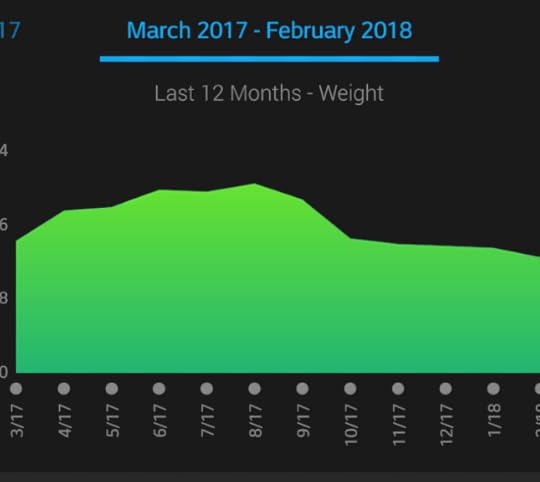
Needless to say, I didn’t stop after the 21 days. I have now been primal for 6 months and have never felt better. I’ve lost over ten pounds without even really trying. I love my eggs, avocados, nuts, berries, veggies, whole-fat Greek yogurt, and meat. My husband was skeptical at first, but saw my success and joined me in this lifestyle. He lost almost 20 pounds that he hadn’t even realized he’d slowly packed on over time.
I am currently training for the Boston Marathon and can easily go through the day after a run without ever feeling ravenous. If I have to wait to eat or skip a meal, it’s no big deal. I also make sure to avoid chronic cardio by keeping my easy days easy, and my hard days hard.
Thanks, Mark! Although I’m not quite ready to give up marathons, I’ll give up grains, sugar, and bad oils any day!


The post I Was Blown Away That I Could Lose Weight Without Running! appeared first on Mark's Daily Apple.



November 8, 2018
Instant Pot Chicken “Noodle” Soup
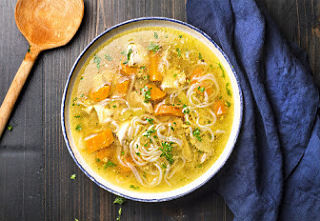 Chicken noodle soup is comfort food that both adults and kids love. When you don’t have the time or the energy to make long simmered, all-day chicken soup, this is the recipe you need. In about an hour you’ll be slurping noodles from a bowl filled with rich, flavorful broth, chicken and yes, you read that right, noodles.
Chicken noodle soup is comfort food that both adults and kids love. When you don’t have the time or the energy to make long simmered, all-day chicken soup, this is the recipe you need. In about an hour you’ll be slurping noodles from a bowl filled with rich, flavorful broth, chicken and yes, you read that right, noodles.
Shirataki noodles, a low-carb noodle alternative, make a tasty stir-fry and are eminently delicious in a bowl of soup. These almost flavorless noodles soak up some of the flavor in the broth, which is made using only dark meat for the richest flavor. The shredded thigh meat mixed in with the noodles makes a filling and satisfying bowl of chicken noodle soup. Low-carb, richly flavorful, and quick and easy means that this is chicken noodle soup everyone can love.
Time in the Kitchen: 1 hour
Servings: 4 to 6
Ingredients
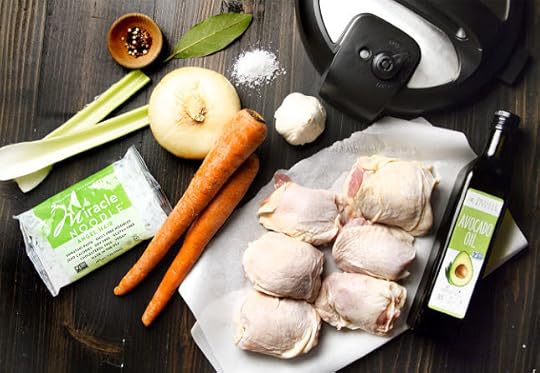
2 1/2 pounds bone-in chicken thighs (about 6 thighs/1.1 kg)
2 tablespoons unsalted butter or avocado oil (30 ml)
2 carrots, peeled and sliced into 1/2-inch rounds
2 celery stalks, cut into ½-inch half-moons
1 onion, chopped (either finely diced or bigger chunks, whichever you prefer)
4 garlic cloves, peeled and smashed
2 teaspoons salt (10 ml)
1 teaspoon whole black peppercorns (5 ml)
1 bay leaf
6 cups chicken stock or water (1.6 L)
1 package/7 ounces/200 g shirataki angel hair noodles
Instructions

Using the sauté function on an electric pressure cooker, heat the butter or oil. Add the carrots, celery, onion and garlic. Sauté about 5 minutes, until lightly browned.
Add the chicken. Season everything in the pot with salt. Add peppercorns and bay leaf. Add the chicken stock or water.
Lock the lid in place, seal the vent, and cook for 15 minutes on high pressure. Release the pressure manually.
Use tongs to transfer the chicken to a plate. When the meat is cool enough to handle, shred the meat off the bones, and return the meat to the pot.
Turn the pressure cooker to “sauté” mode, bringing the broth to a simmer.
Open the package of shirataki noodles and drain the noodles in a colander. Rinse well under cold water.
Add the rinsed shirataki noodles to the soup. Simmer 2 to 3 minutes before serving.
Nutritional Info (per serving):
Calories: 238
Carbs: 6 grams
Fat: 13 grams
Protein: 24 grams
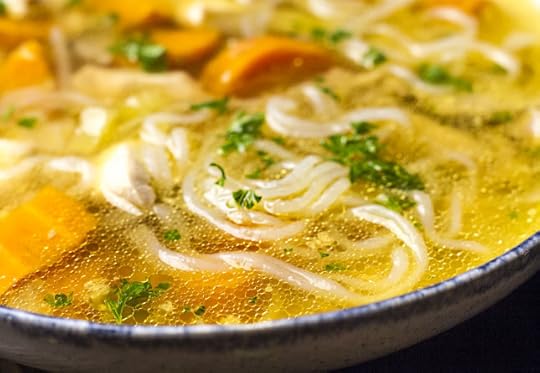

The post Instant Pot Chicken “Noodle” Soup appeared first on Mark's Daily Apple.



November 7, 2018
Fasted Workouts: When They’re More Effective (and How I Incorporate Them)
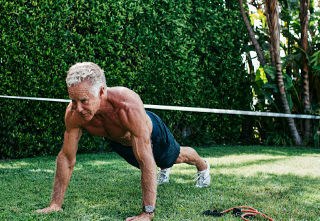 Fasted workouts are a controversial topic in the fitness world. To some, the idea of working out without “carbing up” or doing the pre-workout protein shake is unthinkable. Won’t my performance suffer? Won’t my muscles shrink? Won’t my body think I’m in the middle of some horrible famine and go into starvation mode?
Fasted workouts are a controversial topic in the fitness world. To some, the idea of working out without “carbing up” or doing the pre-workout protein shake is unthinkable. Won’t my performance suffer? Won’t my muscles shrink? Won’t my body think I’m in the middle of some horrible famine and go into starvation mode?
To others, fasted workouts are sacred tools, the perfect antidote to modern decrepitude. When I train in a fasted state, I can will my adipocytes to release fatty acids and feel the heat as they burn, hear the barely audible *pop* of muscle satellite cells replicating and proliferating, and see visions of my future physique through my gaping third eye.
Where does the truth lie? Let’s look….
To begin with, the evolutionary argument—the Grok logic—for fasted workouts is extremely appealing and intuitive.
Humans did not evolve with access to 24-7 fast food restaurants, grocery stores containing hundreds of millions of calories, and food supplies so ample that we often throw out half of it before we’re able to eat it. If paleolithic humans wanted to eat, they had to hunt or gather something—both of which require the expenditure of caloric energy—often on an empty stomach. In fact, these “workouts” for hunter-gatherers probably occurred more often than not in a fasted state.
This doesn’t mean that fasted workouts are ideal or optimal for health, performance, and fat loss. It does suggest that humans have the capacity for working out in a fasted state without falling apart or losing all the benefits normally associated with exercise. The question is if fasted workouts offer any special advantages.
Today, I’m going to dig into the literature to explore the most frequent questions and claims about fasted workouts and arrive as close to the truth as we can.
Are Fasted Workouts Good or Bad for Muscle Gain?
Let’s take a look.
One common argument is that since you’re not eating, which already “stresses” the muscles and deprives them of structural substrate, stressing the muscle with exercise causes it to “melt away.” This is overly simplistic, if attractive.
For one, that first bit is wrong. Reasonable durations of fasting don’t cause muscle loss. In fact, you can do a few days of fasting without incurring any significant muscle loss. The ketones generated during the fast have protein-sparing effects, and the fasting-induced spike in growth hormone also spares muscle from breakdown. There was even a study where blocking growth hormone with a GH blocker caused fasting people to lose 50% more muscle than fasters who didn’t get the blocker.
For two, strength training itself is a powerful signal to your body that your muscles are essential tissues vital to your survival. Your body generally tries to avoid burning through essential tissues. Lifting also increases growth hormone. Paired with the fasting-induced GH boost, your muscles will be in good standing.
Okay, so fasted workouts don’t appear to be bad for gains. Are they good?
Fasted training augments the anabolic response—the ability of muscles to take up protein and get bigger and stronger. A 2009 study found that, compared to athletes who lifted weights after breakfast, athletes who lifted weights in the morning before eating had an augmented anabolic response to a post-workout protein-and-carb shake.
Are Fasted Workouts Good for Fat Loss?
This one makes sense, doesn’t it? When you don’t have exogenous calories coming in, and you go for a run or walk or bike ride, your body should burn more body fat since it’s the only energy source available. But does it actually happen?
Well, short term studies find that fasted cardio increases fat oxidation in the body. People who go for a run in a fasted state have a lower respiratory quotient, an indication of greater fat burning versus glucose burning. One study found that a morning fasted cardio session increased 24-hour fat oxidation by 50% in young men.
An increase in 24-hour fat oxidation doesn’t say much about long term fat loss, however.
Another study followed a group of healthy women for four weeks, placing them on a morning fasted cardio routine. Three mornings a week, the subjects would perform 50 minutes of treadmill cardio at 70% of their max heart rate in a fasted state. Both the fasted group and the control group (who performed the same cardio, just not fasted) maintained a daily 500 calorie deficit. What happened?
There were no differences in fat loss between groups. Both groups lost weight and lost body fat, but fasted morning cardio did not accelerate the loss. A recent analysis of the available research came to the same conclusion: no difference in fat loss or weight loss between fasted workouts and fed workouts.
I’d like to see a similar four-week study done with men, who in my experience and from reading the fasting literature tend to have a more favorable response to extremes in caloric restriction.
This isn’t a perfect fasted workout study, but it’s better than nothing. A group of triathletes was placed on a “sleep-low” program: instead of eating a ton of carbs after their afternoon workouts, they ate none at all. They depleted their glycogen with the workout, ate a very low-carb dinner, and went to sleep. Then they woke up and did low-intensity cardio in a fasted state, which is the equivalent of a normal person going for a walk. The study was interested in performance, not fat loss, but the group who did their cardio in a glycogen-depleted, fasted state lost more fat than the control group.
An old bodybuilding classic for shedding fat is the fasted morning walk. Wake up, consume no calories, and go for a brisk 20-30 minute walk. In those who are already pretty lean but want to get very lean (like bodybuilders preparing for competition), fasted low-level cardio can be very effective. This is the hardest body comp transition—from lean to very lean. Lean is what the body “wants,” and going lower requires getting over the natural tendency to hold on to diminished body fat stores. A fasted walk, jog, or cycling session performed in the aerobic zone almost forces the body fat to release into circulation. Insulin is low. Sensitivity is high. The stage is perfect, in theory.
Are Fasted Workouts Good for Performance?
Yes and no.
To answer this question, we must note the distinction between training and competing. You might perform worse in a given workout if you’re fasting. You’ll probably perform better if you’ve eaten. But if you’ve consistently trained in a fasted state, the metabolic and muscle adaptations you’ll acquire will boost performance when you compete in a fed state. And that’s everything, isn’t it? While it’s fun to go hard in a workout, test your PR, and treat your training session like the world championship, the real reason we train is to adapt to the training and get better, fitter, and faster—whether for a legit competition or to simply get healthier. A fasted workout trains you to perform under difficult physiological conditions of low fuel availability, and that comes in handy. You probably wouldn’t enter a race or powerlifting match in a fasted state, but the fasted workouts you did in the months leading up to competition make you more likely to win.
The two are complementary. Train fasted, race fed.
Sprinting performance appears to suffer. In one study, sprinting athletes who had fasted had impaired speed and power thanks to less springiness. In another, fasted sprinting led to slower reaction times. Again—the question is, do the training adaptations you get from sprinting in a fasted state make up for the acute losses in performance?
Ramadan fasters (no food or drink during daylight hours) who engage in sprint training improve their soccer-specific endurance performance. They may suffer during the training, but they get good training effects.
As for strength training, there isn’t much solid scientific evidence that the fasted state improves or harms performance. One thing I’ve noticed—and have also heard from dozens of anecdotal reports—is that fasted workouts fill me with a special sort of energy. For lack of a better term, it feels more “Primal,” like you’re actually on the razor’s edge of desperation and performance, where your entire being is focused on lifting the weight, sprinting the hill, or spearing the deer that represents the difference between food for a week and total starvation. It’s pretty cool.
Some people report the opposite. Some people seriously lag if they haven’t eaten. They need something in their bellies to have a good workout. This is a subjective thing, and you’ll probably find that it changes from workout to workout. For example, strength workouts and low level aerobic activity (hiking, walking, paddling) go well for me on an empty stomach, while I prefer to have something light to eat before really intense Ultimate Frisbee matches. Figure out what works for yourself.
Implications for Certain Populations and Conditions…
Type 2 Diabetes
Fasted training improves several physiological markers that are especially relevant to people with type 2 diabetes. For one, it improves insulin sensitivity. The basic definition of type 2 diabetes is “extreme insulin resistance”; fasted workouts counter that insulin resistance. It also improves fat burning, another deficiency common in type 2 diabetes.
Keto Dieters
Keto dieters and fat-adapted folks on low-carb, high-fat programs seem to do better in the fasted state. If you’re already adept at burning your own body fat and training in a low-carbohydrate state, training in the lowest-carbohydrate state—a fasted one—isn’t a big leap.
Gender
As I’ve written before, women tend to react more poorly to intermittent fasting, especially fasts exceeding 14 hours. They are simply more sensitive to caloric restriction, seeing as how their biological “programming” prefers they have a steady source of calories in place for growing, feeding, and nursing babies. Whether you have kids or not, that’s what a significant portion of your DNA is geared toward.
That’s not to say fasted training doesn’t work for women. It just might not do anything special compared to fed training. For instance, this study found that whether overweight women did high intensity interval training in a fasted or fed state had no effect on the benefits. Both types of training worked equally well, improving body composition and the ability of the muscles to burn fat.
Other research finds that women can benefit from fasted training, though men may derive unique benefits. In another study, men and women performed fed and fasted endurance training. Both men and women saw better VO2max increases when fasted, but fasted men saw bigger boosts to muscle oxidative capacity. Fasting helped both in this case. It just helped men a little more.
How I Use Fasted Training
These days, most of my workouts are performed in the fasted state. Anything resembling lower level “cardio,” like walking, hiking, standup paddling, and bike rides are all done totally fasted.
Before heavy lifting or HIIT sessions, however, I’ll drink 20 grams of collagen peptides with some ketone salts and often creatine monohydrate. This isn’t to “fuel” me. The collagen provides the raw material my connective tissue (tendons, ligaments, cartilage) needs to adapt to the training stress, the creatine provides the substrate for quick ATP generation for short bursts, and—this is speculative, mostly—the ketones provide brain fuel to prevent “bonking” and act as an epigenetic signal for muscle preservation. This drink doesn’t contain many calories, nor does it provoke a huge insulin response. I’m technically breaking the fast, but I’m retaining most of the benefits.
I always continue the fast after my workouts. Going a few more hours without eating enhances the HGH response, which helps spare muscle burning and augments the adaptive responses. The ability to comfortably fast after a training session is a good sign that you’re fat-adapted. If I were trying to maintain some elite athletic schedule, I’d refill my glycogen stores, but I’m not chasing performance anymore. It just doesn’t make sense to burn through them and eat a bunch of carbs only to go do it again.
I don’t train in a fasted state for magical effects. I’m not expecting any miracles and neither should you. But I do think every healthy human should be able to complete a fasted workout without falling apart or losing more than a step.
I can. How about you? Ever try fasted workouts? How do you use fasting to augment your training?
Thanks for reading, everyone.

References:
Deldicque L, De bock K, Maris M, et al. Increased p70s6k phosphorylation during intake of a protein-carbohydrate drink following resistance exercise in the fasted state. Eur J Appl Physiol. 2010;108(4):791-800.
Marquet LA, Brisswalter J, Louis J, et al. Enhanced Endurance Performance by Periodization of Carbohydrate Intake: “Sleep Low” Strategy. Med Sci Sports Exerc. 2016;48(4):663-72.
Iwayama K, Kurihara R, Nabekura Y, et al. Exercise Increases 24-h Fat Oxidation Only When It Is Performed Before Breakfast. EBioMedicine. 2015;2(12):2003-9.
Schoenfeld BJ, Aragon AA, Wilborn CD, Krieger JW, Sonmez GT. Body composition changes associated with fasted versus non-fasted aerobic exercise. J Int Soc Sports Nutr. 2014;11(1):54.
Aird TP, Davies RW, Carson BP. Effects of fasted vs fed-state exercise on performance and post-exercise metabolism: A systematic review and meta-analysis. Scand J Med Sci Sports. 2018;28(5):1476-1493.
Cherif A, Meeusen R, Farooq A, et al. Three Days of Intermittent Fasting: Repeated-Sprint Performance Decreased by Vertical-Stiffness Impairment. Int J Sports Physiol Perform. 2017;12(3):287-294.
Cherif A, Meeusen R, Farooq A, et al. Repeated Sprints in Fasted State Impair Reaction Time Performance. J Am Coll Nutr. 2017;36(3):210-217.
Aloui A, Driss T, Baklouti H, et al. Repeated-sprint training in the fasted state during Ramadan: morning or evening training?. J Sports Med Phys Fitness. 2018;58(7-8):990-997.
The post Fasted Workouts: When They’re More Effective (and How I Incorporate Them) appeared first on Mark's Daily Apple.



Watch Me on Dr. Oz Today
Hey folks, I’ll be serving up a feature in just a little while, but I wanted to share some news this morning. I’ll be on The Dr. Oz Show today, November 7th, talking all about keto living.
Check your local listings because times vary. I can’t wait to hear what you think!
Sneak Peak: https://bit.ly/2yXwHq4
Airtime information: https://bit.ly/2PHJQwZ
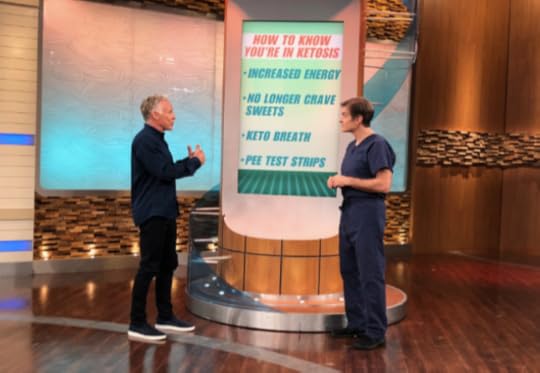
The post Watch Me on Dr. Oz Today appeared first on Mark's Daily Apple.



November 6, 2018
7 Herbal Alternatives to HRT
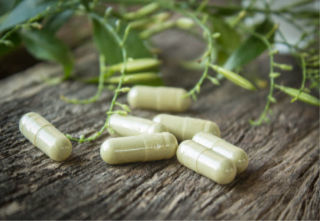
For many women, menopause can introduce new health challenges. In addition to the symptoms that perturb basic quality of life like hot flashes, headaches, night sweats, and irritability, menopause is also associated with higher risk for serious health concerns like osteoporosis, cognitive decline, and metabolic syndrome. This has made the standard treatment for menopause—hormone replacement therapy, or HRT—a multi-billion dollar business.
A few weeks ago, I explored the benefits and risks of HRT. It has its merits certainly, but it’s not for everyone. Today’s post is for those people. Say you’ve waded through the morass of HRT research and would prefer a different route. Or maybe you’ve actually tried conventional or bioidentical HRT and found it just didn’t work for you. Whatever the reason, you’re probably interested in using “natural” products if you can swing it and if it’ll actually help.
Are there herbal alternatives to HRT that actually work?
As a matter of fact, there are.
Black Cohosh
A medicinal herb native to North America, black cohosh was traditionally used to treat a wide variety of conditions, including rheumatism and other arthritic conditions, colds, fevers, constipation, hives, fatigue, and backache. They used it to help babies get to sleep and soothe kidney troubles. In the mid 20th century, it gained popularity in Europe as a treatment for women’s hormonal issues. Modern clinical research bears out its relevance for menopause:
It’s effective against hot flashes, reducing both severity and frequency.
It improves objective markers of sleep quality (the reduction in hot flashes certainly can’t hurt).
It improves insulin sensitivity, which often degrades during menopause.
It improves early post-menopausal symptoms across the board, leading to a 12.9 point reduction in the Green climacteric score (a basic measure of menopause symptom severity).
In one study, black cohosh was comparable to conventional HRT for reducing most menopausal symptoms and better at reducing anxiety, vaginal bleeding, and breast tenderness.
Here’s a great black cohosh product.
Maca
In its native Peru, maca root was traditionally used as a root vegetable (like a turnip or radish), as well as for its pharmacological properties as an aphrodisiac and subtle stimulant. Incan warriors reportedly used it as a preworkout booster before battles. Today, we know it as an adaptogen—a substance that helps your endocrine system adapt to stress, rather than force it in one direction or another.
A 2011 review of the admittedly limited evidence found that maca shows efficacy against menopause. More recently, maca displayed the ability to lower depression and blood pressure in menopausal women. And earlier, maca helped perimenopausal women resist weight gain and menopausal women regain their sexual function and reduce depression and anxiety.
What’s going on here? According to a 2005 study, maca actually lowers follicle-stimulating hormone and increases luteinizing hormone in postmenopausal women, thereby increasing estrogen and progesterone production.
Make sure you buy gelatinized (cooked) maca, as that’s what the studies use.
Red Clover
The red clover blossom is a rich source of isoflavones, estrogen-like compounds that interact with receptors in our bodies and relieve many symptoms of menopause.
Twelve weeks of red clover cuts the Menopause rating score in half (a good thing!).
Twelve weeks greatly reduces the intensity and frequency of hot flashes and night sweats. Including some probiotics has a similar effect.
Red clover also improves vaginal cellular structure and function while (again) improving menopause symptoms and reducing triglycerides.
More exciting, there’s reason to believe that red clover may reduce the risk of breast cancer and improve bone mineral density in menopausal women.
Here’s a potent red clover supplement.
And then there are those herbs and plants with more limited scopes.
Ginseng
Ginseng has limited application in menopause. It improves sexual function, and Korean red ginseng appears to help libido and reduce the total hot flash score, but neither type of ginseng reduces oxidative stress, improves endometrial thickness, or reduces hot flash frequency.
Here’s some Korean red ginseng. Here’s some concentrated ginseng.
Evening Primrose
It’s good for hot flashes, and that tends to improve other things like socializing and sex, but that’s about it.
Here’s some cold-pressed primrose oil.
St. John’s Wort
You might remember St. John’s Wort as an herbal treatment for such conditions as depression and anxiety, but it’s also quite effective against certain symptoms of menopause.
In one study, 3 months of daily St. John’s Wort supplementation helped perimenopausal women go from three hot flashes to one hot flash a day, get better sleep, and have a better quality of life. In another, it took 8 weeks of St. John’s Wort for both perimenopausal and postmenopausal women to reduce the frequency and severity of their hot flashes. Researchers also combined it with black cohosh to successfully treat hot flash-related moodiness.
This is a pretty good product.
Wild Yam
The yam has been used for hundreds of years for menopause treatment. These days, we know it contains estrogen mimetics known as phytosterols with clinical efficacy in menopausal women.
Try this one.
Before you go fill your Amazon cart with supplements and start chowing down on powders and pills, however, make sure you’re making the right move.
Talk to your doctor about the herbal alternatives mentioned today. Discuss and research potential interactions with medications and even supplements you’re already taking. Be sure to cite the relevant references.
Minimize the variables. Don’t start taking everything from this article. Start with one and evaluate.
Don’t underestimate the power of plants. Just because something is “herbal” or “botanical” doesn’t mean it’s completely benign at all doses.
That’s it for today, folks. Take care, and be sure to write in down below.
Have you ever used any herbs or botanicals to treat menopause symptoms? If so, what worked? What didn’t?

References:
Mehrpooya M, Rabiee S, Larki-harchegani A, et al. A comparative study on the effect of “black cohosh” and “evening primrose oil” on menopausal hot flashes. J Educ Health Promot. 2018;7:36.
Jiang K, Jin Y, Huang L, et al. Black cohosh improves objective sleep in postmenopausal women with sleep disturbance. Climacteric. 2015;18(4):559-67.
Mohammad-alizadeh-charandabi S, Shahnazi M, Nahaee J, Bayatipayan S. Efficacy of black cohosh (Cimicifuga racemosa L.) in treating early symptoms of menopause: a randomized clinical trial. Chin Med. 2013;8(1):20.
Zheng TP, Sun AJ, Xue W, et al. Efficacy and safety of Cimicifuga foetida extract on menopausal syndrome in Chinese women. Chin Med J. 2013;126(11):2034-8.
Lee HW, Choi J, Lee Y, Kil KJ, Lee MS. Ginseng for managing menopausal woman’s health: A systematic review of double-blind, randomized, placebo-controlled trials. Medicine (Baltimore). 2016;95(38):e4914.
Lee MS, Shin BC, Yang EJ, Lim HJ, Ernst E. Maca (Lepidium meyenii) for treatment of menopausal symptoms: A systematic review. Maturitas. 2011;70(3):227-33.
Stojanovska L, Law C, Lai B, et al. Maca reduces blood pressure and depression, in a pilot study in postmenopausal women. Climacteric. 2015;18(1):69-78.
Brooks NA, Wilcox G, Walker KZ, Ashton JF, Cox MB, Stojanovska L. Beneficial effects of Lepidium meyenii (Maca) on psychological symptoms and measures of sexual dysfunction in postmenopausal women are not related to estrogen or androgen content. Menopause. 2008;15(6):1157-62.
Shakeri F, Taavoni S, Goushegir A, Haghani H. Effectiveness of red clover in alleviating menopausal symptoms: a 12-week randomized, controlled trial. Climacteric. 2015;18(4):568-73.
Lipovac M, Chedraui P, Gruenhut C, et al. The effect of red clover isoflavone supplementation over vasomotor and menopausal symptoms in postmenopausal women. Gynecol Endocrinol. 2012;28(3):203-7.
Hidalgo LA, Chedraui PA, Morocho N, Ross S, San miguel G. The effect of red clover isoflavones on menopausal symptoms, lipids and vaginal cytology in menopausal women: a randomized, double-blind, placebo-controlled study. Gynecol Endocrinol. 2005;21(5):257-64.
Lambert MNT, Thorup AC, Hansen ESS, Jeppesen PB. Combined Red Clover isoflavones and probiotics potently reduce menopausal vasomotor symptoms. PLoS ONE. 2017;12(6):e0176590.
Beck V, Rohr U, Jungbauer A. Phytoestrogens derived from red clover: an alternative to estrogen replacement therapy?. J Steroid Biochem Mol Biol. 2005;94(5):499-518.
Abdali K, Khajehei M, Tabatabaee HR. Effect of St John’s wort on severity, frequency, and duration of hot flashes in premenopausal, perimenopausal and postmenopausal women: a randomized, double-blind, placebo-controlled study. Menopause. 2010;17(2):326-31.
Briese V, Stammwitz U, Friede M, Henneicke-von zepelin HH. Black cohosh with or without St. John’s wort for symptom-specific climacteric treatment–results of a large-scale, controlled, observational study. Maturitas. 2007;57(4):405-14.
The post 7 Herbal Alternatives to HRT appeared first on Mark's Daily Apple.



November 5, 2018
Weekly Link Love — Edition 2

Research of the Week
The latest MDMA trial finds it’s 76% effective at treating PTSD. Full FDA approval expected by 2021.
As many as 500,000 years ago, Arabia was green, and hominids were living and traveling through there.
Scare yourself to recalibrate your emotions.
Increased frequency of global travel may actually reduce the danger of global pandemics.
CoQ10 is good for type 2 diabetics.
New Primal Blueprint Podcasts

Episode 287: Victoria Field: Host Elle Russ chats with Victoria Field, a world-renowned expert in high-performance and cancer-centered keto nutrition for people and dogs.
Each week, select Mark’s Daily Apple blog posts are prepared as Primal Blueprint Podcasts. Need to catch up on reading, but don’t have the time? Prefer to listen to articles while on the go? Check out the new blog post podcasts below, and subscribe to the Primal Blueprint Podcast here so you never miss an episode.
Media Schmedia
New surgery students haven’t the manual dexterity necessary to succeed.
Reader Question of the Week
Hi Mark
This article hit home for me as I’m 57 and living with a slightly enlarged prostate. One of my favourite activities is getting out on my road bike for a good 50 to 75 km ride. I’m wondering if you would know if that is aggravating my prostate? I’ve read so many conflicting reports I’m hoping you may have some insight. Thanks !
Great question.
There may be short-term increases in prostate stress. In men 50 or over, a long bike ride (55-160 km) transiently increases PSA levels by an average of 9.5% when measured 5 minutes post-riding. The longer the ride and the older the rider, the larger the increase. In a sample of 129 riders, just two men had elevated PSA levels before the ride. After the ride, six men had elevated PSA levels. All told, it isn’t very significant, and the authors suggest 48 hours is enough for PSA to return to baseline.
But there probably isn’t any chronic effect. A 2015 meta-analysis of the available research suggested “that there is no effect of cycling on PSA.”
Large observational studies have found road cycling to be linked to increased genital numbness, urethral stricture (where the urethra is blocked or obstructed), but not to any actual sexual problems or impaired urinary function. Oddly enough, cycling-related numbness of the butt was linked to worse sexual function. Padded seats, raising the handlebars to be even with the seat, and using padded shorts seem to improve the symptoms.
I wouldn’t worry. Exercise itself is good for prostate health, as I explained in the prostate post a couple weeks ago. So my gut feeling is that cycling is probably a net plus for the prostate.
Interesting Blog Posts
Paleobiologists attempt to debunk the paleo diet, fail miserably.
Ketosis and arthritis (or the lack thereof).
Social Notes
Halloween has passed, but these NomNomPaleo Halloweenies we made are a great way to get kids involved in the cooking (and eating) process.
Brad Kearns’ last couple podcasts have been great. First, his interview with Vinnie Tortorich and then a “breather” episode where Brad chats about Deepak Chopra insights, longevity, and high-jumping.
Everything Else
AI-created painting fetches hefty price.
Why did thousands of usually-solitary deep sea octopuses gather in the waters outside of Monterey?
I’d vote for him based off this alone.
Wristbands to predict and eventually regulate mood.
Things I’m Up to and Interested In
I wouldn’t be surprised if it was causal: More screen time, less psychological well-being (among teens).
You know what they say: “Lie with Neanderthals, wake up with HPV.”
Article I’m loving: “Why Forests Give You Awe.”
Result you might not have expected: Those who are struggling benefit more from giving advice than receiving it.
Miscellaneous topic I enjoyed: The smell artist.
Question I’m Asking
Will AI-created art—paintings, books, music, etc—ever replace or surpass human art? Or will “something” always be missing?
Recipe Corner
Easy paleo frittata.
Squash tots.
Time Capsule
One year ago (Oct 28– Nov 3)
Brown Bag Redo—Kids Edition – How and what to make your kids for lunch/
7 Subjective Longevity Markers to Track (and Fix) – Live longer, live better.
Comment of the Week
“Imagine if our ancestors had internet news and smart phones. All day long, they’d be getting alerts. ‘Ging of Siberia was mauled by a polar bear.’ ‘Huge attack by Comanches kills 100s. Slaves captured.’ ‘Viking ruler overthrown by brother. Bloodiest battle in Katagut.’ ‘Child goes missing in the bush. Feared eaten by dingos.’ ‘Mayan leader Xocolatte accused of once throwing a cup of coffee at ex-girlfriend.’ ”
– Becky imagines if our ancestors had access to the global news cycle.

The post Weekly Link Love — Edition 2 appeared first on Mark's Daily Apple.



Weekly Link Love—Edition 2

Research of the Week
The latest MDMA trial finds it’s 76% effective at treating PTSD. Full FDA approval expected by 2021.
As many as 500,000 years ago, Arabia was green, and hominids were living and traveling through there.
Scare yourself to recalibrate your emotions.
Increased frequency of global travel may actually reduce the danger of global pandemics.
CoQ10 is good for type 2 diabetics.
New Primal Blueprint Podcasts

Episode 287: Victoria Field: Host Elle Russ chats with Victoria Field, a world-renowned expert in high-performance and cancer-centered keto nutrition for people and dogs.
Each week, select Mark’s Daily Apple blog posts are prepared as Primal Blueprint Podcasts. Need to catch up on reading, but don’t have the time? Prefer to listen to articles while on the go? Check out the new blog post podcasts below, and subscribe to the Primal Blueprint Podcast here so you never miss an episode.
Media Schmedia
New surgery students haven’t the manual dexterity necessary to succeed.
Reader Question of the Week
Hi Mark
This article hit home for me as I’m 57 and living with a slightly enlarged prostate. One of my favourite activities is getting out on my road bike for a good 50 to 75 km ride. I’m wondering if you would know if that is aggravating my prostate? I’ve read so many conflicting reports I’m hoping you may have some insight. Thanks !
Great question.
There may be short-term increases in prostate stress. In men 50 or over, a long bike ride (55-160 km) transiently increases PSA levels by an average of 9.5% when measured 5 minutes post-riding. The longer the ride and the older the rider, the larger the increase. In a sample of 129 riders, just two men had elevated PSA levels before the ride. After the ride, six men had elevated PSA levels. All told, it isn’t very significant, and the authors suggest 48 hours is enough for PSA to return to baseline.
But there probably isn’t any chronic effect. A 2015 meta-analysis of the available research suggested “that there is no effect of cycling on PSA.”
Large observational studies have found road cycling to be linked to increased genital numbness, urethral stricture (where the urethra is blocked or obstructed), but not to any actual sexual problems or impaired urinary function. Oddly enough, cycling-related numbness of the butt was linked to worse sexual function. Padded seats, raising the handlebars to be even with the seat, and using padded shorts seem to improve the symptoms.
I wouldn’t worry. Exercise itself is good for prostate health, as I explained in the prostate post a couple weeks ago. So my gut feeling is that cycling is probably a net plus for the prostate.
Interesting Blog Posts
Paleobiologists attempt to debunk the paleo diet, fail miserably.
Ketosis and arthritis (or the lack thereof).
Social Notes
Halloween has passed, but these NomNomPaleo Halloweenies we made are a great way to get kids involved in the cooking (and eating) process.
Brad Kearns’ last couple podcasts have been great. First, his interview with Vinnie Tortorich and then a “breather” episode where Brad chats about Deepak Chopra insights, longevity, and high-jumping.
Everything Else
AI-created painting fetches hefty price.
Why did thousands of usually-solitary deep sea octopuses gather in the waters outside of Monterey?
I’d vote for him based off this alone.
Wristbands to predict and eventually regulate mood.
Things I’m Up to and Interested In
I wouldn’t be surprised if it was causal: More screen time, less psychological well-being (among teens).
You know what they say: “Lie with Neanderthals, wake up with HPV.”
Article I’m loving: “Why Forests Give You Awe.”
Result you might not have expected: Those who are struggling benefit more from giving advice than receiving it.
Miscellaneous topic I enjoyed: The smell artist.
Question I’m Asking
Will AI-created art—paintings, books, music, etc—ever replace or surpass human art? Or will “something” always be missing?
Recipe Corner
Easy paleo frittata.
Squash tots.
Time Capsule
One year ago (Oct 28– Nov 3)
Brown Bag Redo—Kids Edition – How and what to make your kids for lunch/
7 Subjective Longevity Markers to Track (and Fix) – Live longer, live better.
Comment of the Week
“Imagine if our ancestors had internet news and smart phones. All day long, they’d be getting alerts. ‘Ging of Siberia was mauled by a polar bear.’ ‘Huge attack by Comanches kills 100s. Slaves captured.’ ‘Viking ruler overthrown by brother. Bloodiest battle in Katagut.’ ‘Child goes missing in the bush. Feared eaten by dingos.’ ‘Mayan leader Xocolatte accused of once throwing a cup of coffee at ex-girlfriend.’ ”
– Becky imagines if our ancestors had access to the global news cycle.

The post Weekly Link Love—Edition 2 appeared first on Mark's Daily Apple.



November 2, 2018
The Primal Worldview Changed My Life For the Better
It’s Friday, everyone! And that means another Primal Blueprint Real Life Story from a Mark’s Daily Apple reader. If you have your own success story and would like to share it with me and the Mark’s Daily Apple community please contact me here. I’ll continue to publish these each Friday as long as they keep coming in. Thank you for reading!

Mark Sisson encourages you live a really enjoyable life. I did not think it was difficult to stick to the Paleo Diet. I was 50. I found Mark Sisson and Loren Cordain on YouTube. Soon I would be buying cookbooks and enjoying my health. It sounded true to me and I jumped on board.
I had been constipated for 40 years. Both my parents were constipated their whole life. I had believed in All Bran and Raisin Bran and healthy muffins. My mother taught me to bake bread in my teens. What a joy, it could not be wrong. In high school an instructor recommended “Diet for a Small Planet.” A few years later in college I became a vegetarian. Many of my friends were vegetarians. It was obvious that we did not need to kill innocent animals and eat them. I ate beans and rice, tofu and vegetables, peanut butter and beer.
Around five years after college I visited an acupuncturist for muscle pains. He suggested that I eat meat and fish. So, for the next 20 years I would primarily be vegetarian but would eat meat and fish. About this time I would eat a breakfast cereal in the morning, a sandwich and potato chips for lunch, and for dinner it was often pasta followed by Ben and Jerry’s on the couch. Beer and wine were being consumed for fun quite often. I did not think that any of this was bad for my body. I ignored or made up other reasons why I was constipated and having chronic pain.
Chronic pain. I injured my knee skiing in my late 20s. No surgery, only rehab. I thought it would heal. Knee pain lasted for years. Wore a support on it for a long time. Got it needled by acupuncturist. Took pain relief. Other chronic pain areas developed, like both wrists and both elbows. Used supportive strapping aids on these parts for years. It felt like the muscle was pulling away from the bone. I figured it was my active lifestyle and normal. I wasn’t sleeping that well, since I would wake up with pain in the arms. The thought that my pain came from food was never considered. It was misery. It went on.
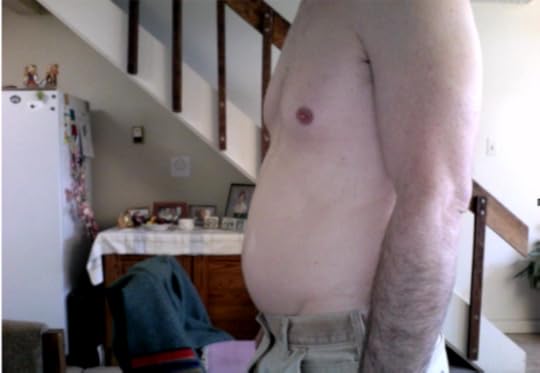
I was changing my diet before The Paleo Diet. The first change was dairy. I went dairy free to help my sinus issues. Then I tried gluten free to help my sinus issues. Sugar was still off the radar, as I was eating gluten free cookies, breads and pasta. I laughed off my coffee and donut at 10 a.m. and M&Ms at 3 p.m. Years went by. It was in 2013 that I changed.
It was one moment on YouTube. Then another. What do you mean a Paleo diet? Click, Click, Click. I went to thepaleodiet.com and read what to eat on the Paleo diet.
Mark Sisson was thoughtful and understood what was going on. I couldn’t get enough. Primal became my diet. I owned it.
I mainly started eating more vegetables. Breakfast had been cereal and now became eggs, bacon and vegetables. Lunch went from rice and beans to meat and vegetables. Dinner became big chicken salad.
I became regular and have never turned back. I felt great. Chronic pain went away. My biggest worry had become a hip that I thought would need replacement in the future. The inflammation slowly went away. It seems to be fine.
Weeks before going Paleo I was planning on buying spray on salad dressing to lesson the amount of oil. Now at 57, I happily use Primal Kitchen® dressing and pour it on heavily. What a sea change.

I’m thankful that I am not addicted to sugar anymore.
I’m thankful for beautiful movement of Taoist Tai Chi.
I’m thankful for Eckhart Tolle for the awareness of gaps between thought.
I’m thankful to Mark Sisson and the whole Paleo/Primal worldview that changed my life for the better.
[Final photo] Six months later.
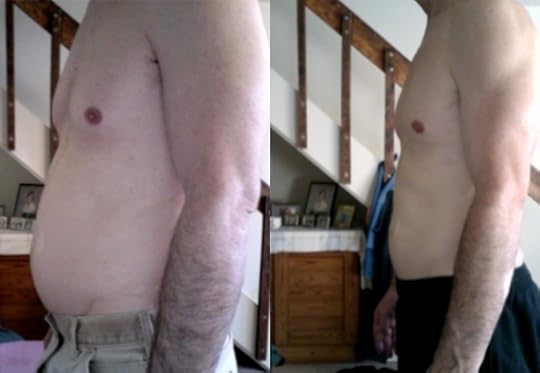

The post The Primal Worldview Changed My Life For the Better appeared first on Mark's Daily Apple.



Mark Sisson's Blog
- Mark Sisson's profile
- 199 followers



